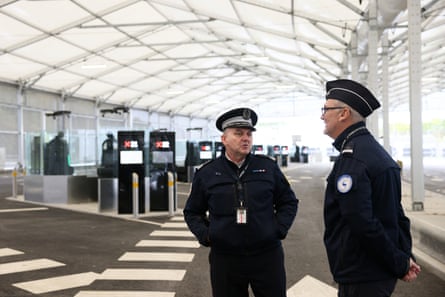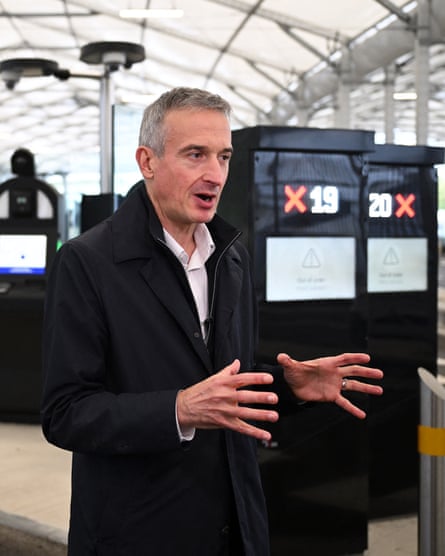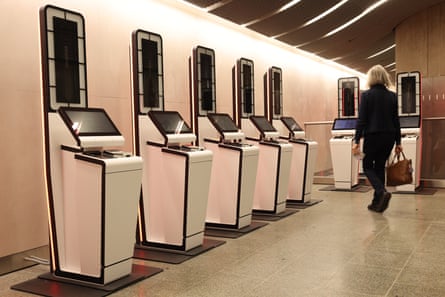Years in the planning, and years in the postponement: EES day has finally arrived. The EU’s new entry-exit system is modernised and streamlined – but possibly still not quite ready – for action.
From 12 October, non-citizens of the EU will start having to register their biometric information at the border – with faces photographed and fingerprints scanned – before being allowed into Europe’s Schengen area.
After helping draw up the scheme a decade ago, the post-Brexit UK now finds itself lumped with nations from Azerbaijan to Zimbabwe outside the bloc. Hopes of prior registration via an app have not materialised, and the whole biometric process must still take place at each airport, crossing or port.
That will have a particular sting for Britons on a short cross-Channel hop, where the official French border is juxtaposed on British soil. Aside from the indignity of queueing at a London terminal or by the white cliffs of Dover to relay bodily information to a Euro-database, train, tunnel and sea passengers uniquely need to complete EES formalities before the actual journey to Europe.

The affected operators – Eurostar, Eurotunnel and the Port of Dover – have all had to redraw their processes and facilities and invest millions in computer kiosks and staff, to various degrees of readiness.
At Dover and Eurotunnel, passengers will need to park and get out of cars (bar in exceptional circumstances such as disability, where border officers can use a tablet to process details). Dover quickly pointed out the potential for renewed traffic hell on the road to the constrained port, after tighter post-Brexit border checks had already led to the government drawing up contingency traffic schemes.
Eurotunnel’s owner Getlink, which has more space and funds, was the first to declare an €80m investment in border tech for its Le Shuttle service, which takes cars and lorries through the tunnel on large vehicle trains.
It hopes that, by minimising any disruption, EES can give it a competitive advantage. Unveiling its bespoke EES road lanes, gantries, shelter and booths at Folkestone this week, which can process 2,000 people an hour at peak times, the chief executive, Yann Leriche, said: “There is no excuse not to be ready. The only risk I see for ourselves is that others are not ready and they are going to cry so loud and manage to convince people to postpone their journey.
The unready, he claimed, “didn’t want to look at EES and by looking away they thought it would go away”.

Given prior border uncertainty and U-turns, that could have been a decent strategy. The Port of Dover did nonetheless spend £17m last year on a canopy bestriding lanes on the eastern docks for EES, the function of which is now unclear as it has since decided to locate the EES booths more than a mile away on newly reclaimed land in the western docks.
A spokesperson said the port was now confident of avoiding issues, especially given the phased rollout over six – or even nine – months now confirmed by the EU.
Yet the EU’s latest concession to the laggards means no one wants to be the first to force red tape on all their customers. Until January, Eurostar will simply be “inviting” regular travellers to register; Eurotunnel and Dover will start with coach passengers and freight, and cars from November.
For Le Shuttle, vehicles will be directed into lanes depending on the nationality of the driver and passengers. Non-EU citizens who need to comply with EES – most cars at Folkestone – will be on a new loop, waiting at a barrier where number plates are automatically scanned and drivers directed to an allocated kiosk. All passengers have to get out of the car and use the kiosk’s touch screens to show their passport, confirm their immigration status, be photographed and (bar under-12s) scan their fingerprints.
When the Guardian tried Eurotunnel’s kiosks, the screen time alone for EES took just under two minutes, per person. Passengers still have to pass through French passport checks. Once registered, on exiting the EU or on subsequent trips within three years, the process is slightly shorter, using facial recognition (but not prints) in the manner of e-gates at airports.
after newsletter promotion
Eurostar’s EES footprint for train passengers at St Pancras is comparatively small. It claims that the time spent in the new zones completing the process can be squeezed into the current 75-minute window passengers are urged to factor in at the station before departure. It has 49 standard kiosks spread over two rooms, usurping a former cafe, a small “premier” EES zone and, upstairs, an emergency overflow zone should things get desperate.
Confusingly, Eurostar required answers to four additional questions on the screen, which Eurotunnel have not included. In a Guardian test, passengers needed to confirm whether or not they have accommodation, a return ticket, sufficient funds and “medical insurance” – a term Eurostar said will now be changed to “travel insurance”. A message on the screen warns that the answers are “binding” and passengers may have to provide proof.
How long the full process takes in real life, with potentially stressed, confused and encumbered passengers setting off on holiday or work trip, remains to be seen. All operators promise to have additional staff to help customers navigate the screens, and will send instructions out with tickets.

The EU concession of a six-month introductory period before all passengers have to be registered – and a further 90 days when EES can be scaled back if chaos occurs – owes less to Britain’s unique circumstances than fears within the EU. Some airports have long had kiosks in place – but concerns remain about processing large numbers of incomers from visa-waiver countries, particularly American tourists.
Germany will phase in the service starting with a small airport in Stuttgart and building up to operations in Frankfurt, one of the busiest airports in Europe.
Only one country in the EU, Sweden, is expected to use a new phone app to allow visitors speedier entry, and only at selected border points. Frontex, the EU border agency, had developed an app that would allow passengers to at least pre-register passport details, leaving just the fingerprinting and facial image capture at the point of arrival. Five other states “are preparing for or working on the integration of the app in their national systems”, a spokesperson said.
Border officials have been told they have discretion to suspend EES if queues are building. “The biggest message we have now is that this is progressive and we have different safeguards for all member states if there is a sudden spike in passengers in lines,” an EU source said.

 3 months ago
46
3 months ago
46

















































